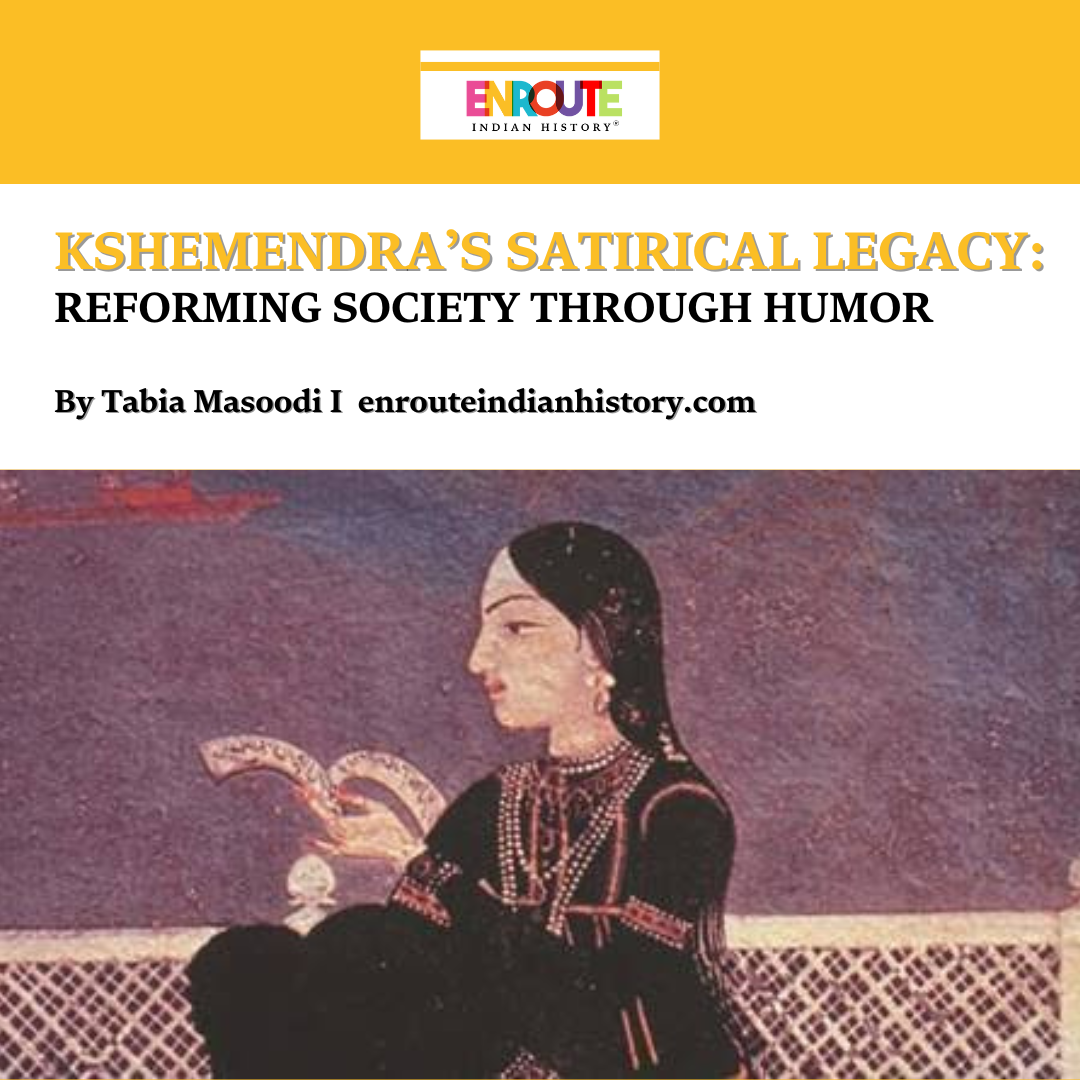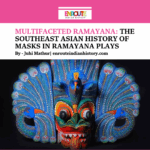Kshemendra’s Satirical Legacy: Reforming Society Through Humor
- iamanoushkajain
- June 13, 2025

By Tabia Masoodi
The expression “Comedy in tragedy,” tells us that Humans have a quality to laugh at the absurdities of life and provoke deeper emotions to uncover its truth and aim to eliminate them. Satire is one such genre of literature that criticises human vices, social standards, and the political system with the goal of social improvement by using humour, irony, exaggeration and mockery. Satire was born in the ancient civilisations of Greece and Rome
and uses a kaleidoscope of forms – novels, plays, films, television and even street theatre to wield its razor-shaped wit slicing through life’s absurdities, hypocrisies and corruptions to inspire transformation.
In Kashmiri literature, satire is a rich and essential component of the area's cultural legacy. It has been embraced as an instrument for social criticism and commentary, often mixing humour with weighty subjects with Kshmendra standing out as the most celebrated satirist. Kshmendra was a legendary polymath of 11th-century Kashmir and a pioneering figure of satire in Sanskrit literature.
BIOGRAPHY OF KSHEMENDRA
Kshemendra, who lived from 990 to 1070 C.E. in Kashmir, came from a well-to-do and cultured family with a diverse educational background. His father, Prakashendra, was a descendant of Jayapida's minister Narendra. Kshemendra was born a Shaiva but later converted to Vaishnava and was also influenced by Buddhism. He wrote about both Vaishnavism and Buddhism. Under the guidance of the greatest teacher of his time,
Abhinavagupta, who himself was a celebrated Shaiva philosopher and literary expert, he excelled in his literary endeavour. Kshemendra wrote his works during the reign of the Kashimirian king Ananta and his son Kalasa; as such, he may be assigned to the second and third quarters of the eleventh century C.E. (Sharma, 2017). He studied all sciences and arts available in Kashmir at his time and acquired extensive expertise in mathematics, grammar, astrology, medicine, surgery, politics, erotica, and Buddhist philosophy. Kshemendra's life is narrated by his son Somendra in the Avadana Kalpalata preface and other writings. Kshemendra called himself Vyasadasa (Slave of Vyasa), a title he probably acquired after finishing his shortened version of Mahabharata, the Bharatamanjari. However, in Lokaprakasa, it is mentioned that Kṣhemendra was a disciple of sage Vyasadasa, son of Parasara. Most probably, Kshemendra expressed his reverence to sage Vyasadasa by naming himself with that name(Devi, A.,2017).
Kshemendra authored satirical and didactic sketches, narratives, poetry, rhetorical treatises, devotional literature as well as abridgements of various Hindu scriptures including Mahabharata and Ramayana. Kshemendra's earliest dated work is Brihatkathāmañjari, which he completed in 1037 CE. This text is a verse summary of the lost Bṛhatkathā, originally authored by Gunadhya, and represents an abridged version of the "Northwestern" recension of the Great Story. It marked the beginning of his prolific literary career, which extended until 1066 CE with his latest known work, Daśavataracharita. Kshemendra’s significant contribution to Sanskrit literature is in regard to satire. He delivers social satire that is infused with sarcasm and humour. The descriptive prowess of his writing, in terms of phrasing and characterisation, is a signature of his literary excellence. His eight-chapter long poem Samayamatrika(The Courtesan's Keeper) written in 1050 C.E. vividly describes the arts and trickeries of the harlot. The account of a courtesan's wanderings in the Valley is told by him in this piece. Strolling musicians, women beggars, shopgirls, saints, robbers, and other social classes are all the subjects of this intriguing example of satire, which is uncommon in Sanskrit literature.
Kshemendra’s satirical works, such as Kalāvilāsa, Deśopadeśa, and Narmamālā, provide a detailed description of 11th-century Kashmir. He did social commentary using humour and irony to critique flaws like greed, corruption, and hypocrisy, aiming to reform the mindset of the people. Kshemendra’s satire was bold yet constructive, blending realism with moral critique to address issues that find relevance even today.
SOCIO-POLITICAL DESCRIPTION OF 11TH-CENTURY KASHMIR
Kshemendra wrote various treatises during the reign of King Ananta of Kashmir (1028- 1063C.E.) and his son and successor, King Kalasha (1063-1089C.E.). The indicated period, i.e. the early medieval period in Kashmir's history, was unrest and instability. King Ananta was a weak ruler. He initially abdicated the throne to his son, Prince Kalasha, but eventually reclaimed the throne (Abrol, 2020). Due to the inability of the ruler to maintain stability in the region, the bureaucrats and land aristocrats gained so much power that challenged even the king, as a result, they abused the people. King Ananta was involved in reckless extravagance that resulted in huge debts, it was resolved through Queen Surayamati, wife of King Ananta, personal funds. Queen Suryamati was a significant player in administrative affairs and helped stabilise the kingdom temporarily.
Due to the region's dire political circumstances, there have been numerous uprisings against the ruling class. This instability is reflected in Kshemenda's works. Kshemendra's satire works clearly show the socio-political setup of 11th-century Kashmir. Through his work, he
critiqued the social evils of that time. He touched on all aspects of society's crimes, from corruption to hypocrisy and moral decay. He questioned the shortcomings of all the social institutions of the era through his writing, including corrupt official machinery, merchant avarice, bureaucratic inefficiencies, and exploitation by different social strata.
KSHMENDRA’S MAJOR SATIRICAL WORKS
Kshmendra was deeply troubled by to vices of the society. He was very concerned about the downtrodden, unlettered common people and courtesans among others. He lay bare the truth about the misuse of power by the elites and the abuse they perpetuated. He used satire as a tool to expose these vices and aimed to influence change. Kshemendra believed that satire could shame individuals into abandoning anti-social behaviours and uplift society from its degraded state. Kshemendra outpoured all his anguish into his collection of three satirical works – Kalavilasa, Naramamala and Desopadesa.
KALAVILASA
Kalavilasa translates to A Dalliance with Deceptions is a satirical work that explores the themes of corruption, greed, hypocrisy, moral decay and human folly. The work is part of a collection of three satirical causeries containing ten cantos and 551 verses. The literary work exposes the social evils that have befallen humankind and remain prevalent among different social strata. The story is centred around Mulladeva, the king of thieves and a well-known trickster, who has garnered immense wealth through his arts of deception. In each canto, a story is placed to illustrate his explanation and strengthen his moral judgements(Devi, A., 2017). Kshmendra criticises bureaucrats and other societal figures through the story of Mulladeva, who describes their cunning ways and the arts of deception through sharp humour and criticism.
The story follows Mulladeva and his disciple Chandragupta, the son of a merchant, who has come to learn the tricks of deception from Mulladeva. Each canto follows a social evil and a lecture by Mulladevi on how to achieve the trick to play out that deception. For instance, in canto one is a lesson on hypocrisy or dhambha, Mulladeva tells his disciples a story of how hypocrisy was born out of divine intervention when god through his powers sensed that humans were not able to fully enjoy while accumulating wealth, therefore, god created hypocrisy for people to thrive. He describes Dhamba as a perfect ascetic sent to Earth from heaven, where it was divided into a thousand pieces and entered into the hearts of officers, lawyers, teachers, children, ascetics, doctors, goldsmiths, astrologers, businessmen, dancers, actors, singers, servants and exists in every sphere of human life. The following cantos contain similar stories that turn the vices into virtues. Kshemendra follows sarcasm, humour and realism to paint this story that resonates with scholars and masses alike.
NARAMAMALA
Naramamala translates to A Garland of Mirth is the second of the collection that follows a similar theme with a specific social and moral commentary on bureaucratic corruption and its exploitation of the common masses. The officials, the accountants, the record keepers and the clerks are depicted under the title Kayastha. In the Narmamala, Kshemendra also discloses various evil practices. The surgeon, the Buddhist nun and other groups of mean crooked selfish persons(Devi, A., 2017). The story contains three chapters(Parihasas) with 406 verses that follow a linear storyline.
In the story, Kshemendra calls the Kayastha demons and experts at cheating people. The narrative opens with a satirical mythical explanation of the Kayastha's genesis, depicting them as the offspring of a demon who was given the ability by Kali to persecute humans with the "weapon of the pen." In the guise of religious piety, it describes how these officials abuse their power to plunder temples, take advantage of the locals, and amass fortune. The Grhakrtyadhipati or chief officer and his staff are portrayed as crafty manipulators who thrive on duplicity. The story also tells readers about the downfall of these corrupt officials despite amassing such wealth, power and success. The story also takes a dig at an astrologer,
physician and guru, who came to cure the bureaucrat’s wife but lacked knowledge but are proud men. Kshemendra always followed realism which made his work relatable among the masses. This story is no exception to that. The satire has a sharper and more direct tone in criticising the faults of officials.
DESOPADESA
Desopadesa(Advice from the Countryside) is the third of the collection of satirical works of Kshemendra containing eight chapters or Upadesas(advice) with 300 verses. The work does not follow a central theme rather it is didactic blending satire with ethical guidance. It depicts a morally corrupted society that thrives on greed and manipulation. Each Upadesas contains a description of each of the characters who are wicked and morally degraded. These included miser, prostitutes, bawd, students, wife of an old man and hypocritical elites. He uses humour and irony to describe these individuals and the absurd social norms such young wife of an old man highlighting forced marriages. For instance, in the first upadesa, Kshemendra mockingly describes a wicked person by paying homage and calls him a fool who claims to be learned. Kshemendra uses satire to shame individuals into moral behaviours to correct societal flaws. The persistent ability of irony and scorn to subvert social standards is demonstrated by
Kshemendra's satirical works. He creates a mirror that reflects the shortcomings of his day, urging readers to face and fix them by skillfully combining humour, sarcasm and wit with criticism. His works demonstrate the universal applicability of satire as a social reform tool while simultaneously offering a window into the past and a timeless observation of human nature.
References
Abrol, Hina S. “Significance of The Compositions of Vyasadasa Kshmendra in Contemporary Times.” Central India Journal of Historical And Archaeological Research, 2020, https://cijhar.in/pdf/2020_Vol_9_No_30_Vol_10_No_31.pdf. Accessed 5 April 2025.
Chandel, Nitin. “A Prolific Writer’s Contribution to Sanskrit Literature.” Research Guru, vol. 11, no. 4, 2018, p. 362. rsearchguru.net,
https://www.researchguru.net/volume/Volume%2011/Issue%204/RG47.pdf.
Sharma, Richa. “Kshemendra: A Versatile Genius.” wwjmrd, 2017,
https://wwjmrd.com/upload/kshemendra-a-versatile-genius_1514979974.pdf. Accessed 5 April 2025.
Devi, A. (2017) Satirical works of Kshemendra (study). Available at:
https://www.wisdomlib.org/hinduism/essay/satirical-works-of-kshemendra-study (Accessed: 5 April 2025).



















